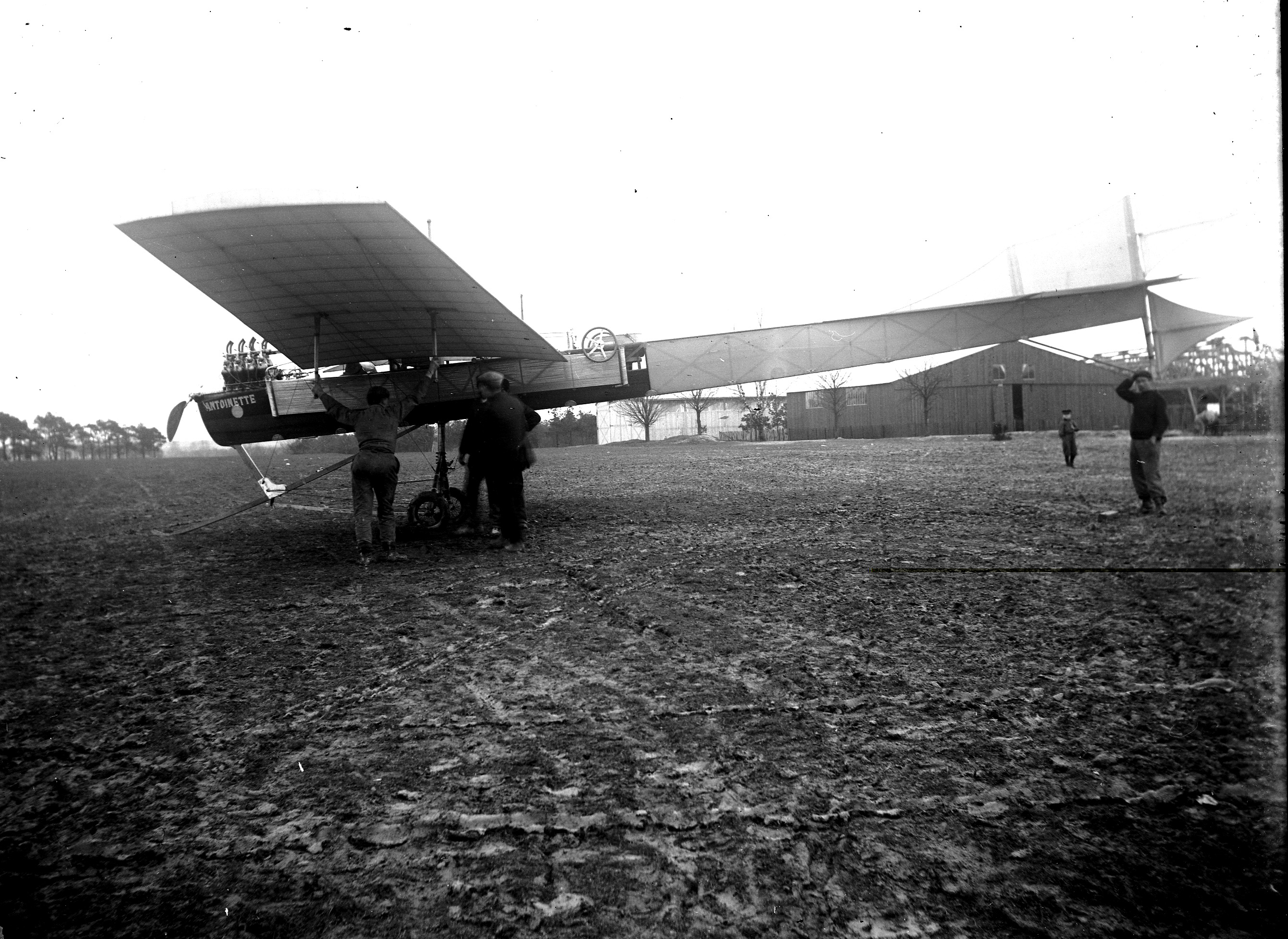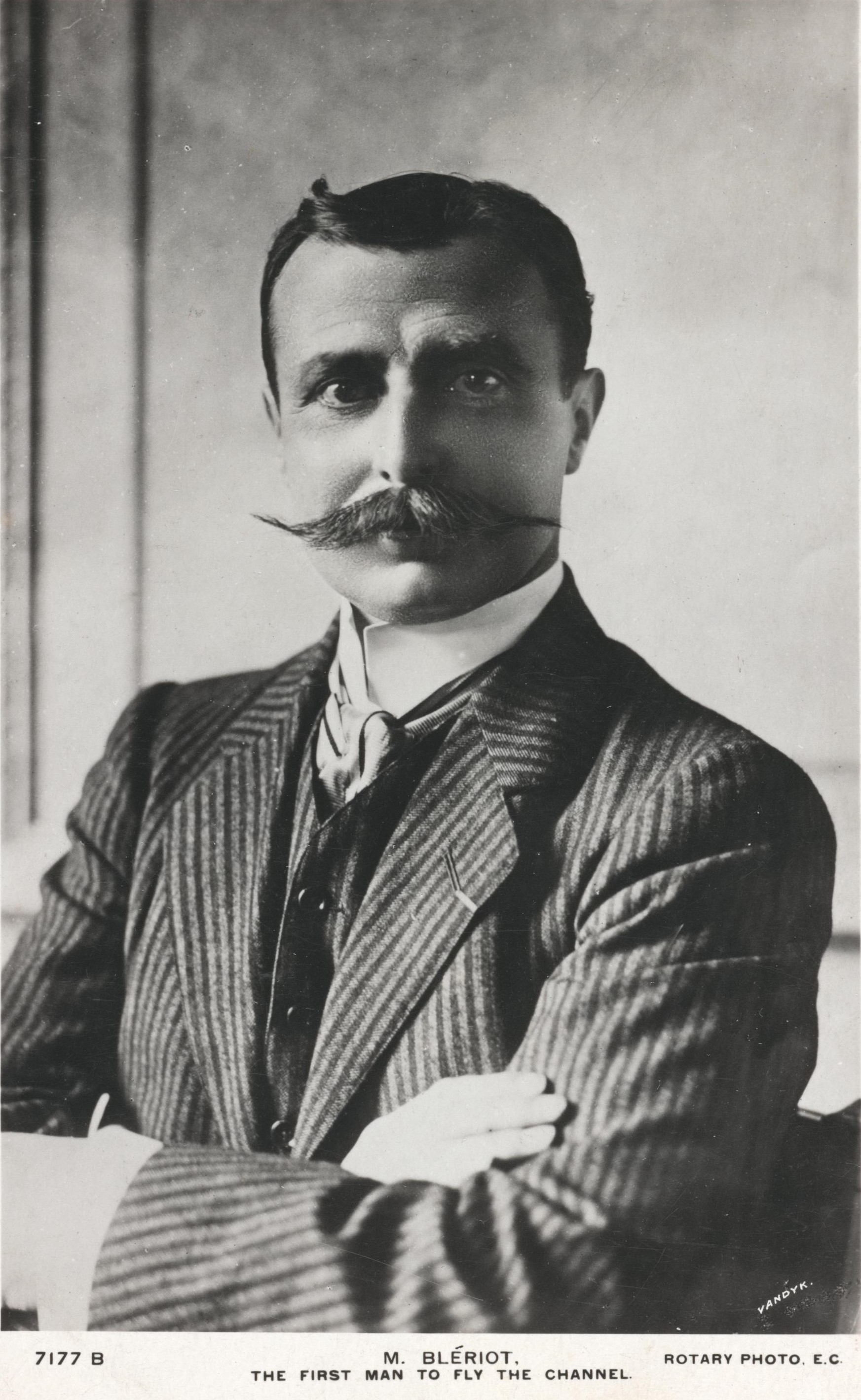|
Antoinette Monobloc
The Antoinette military monoplane, also known as the Antoinette Monobloc or the Antoinette-Latham was an early 3-seat monoplane built in France in 1911 by the Antoinette company in the hope of attracting orders from the French military. It featured a futuristic and aerodynamic design with innovative elements that were ahead of its time, including unbraced cantilever wings, an enclosed fuselage and wheel fairings, and an engine with steam cooling and direct fuel injection. However, due to an under-powered engine, it was barely able to fly and failed to attract orders. Design Aerodynamic streamlining Designed by Léon Levavasseur and Jules Gastambide, and baptized with the name "Monobloc", the aircraft featured a number of innovative aerodynamic refinements for its time. The design was characterized by an enclosed and streamlined body and wings. The design reduced air resistance by the absence of any external bracing wires, and by having its control cables totally enclosed ... [...More Info...] [...Related Items...] OR: [Wikipedia] [Google] [Baidu] |
WikiProject Aircraft
A WikiProject, or Wikiproject, is a Wikimedia movement affinity group for contributors with shared goals. WikiProjects are prevalent within the largest wiki, Wikipedia, and exist to varying degrees within sister projects such as Wiktionary, Wikiquote, Wikidata, and Wikisource. They also exist in different languages, and translation of articles is a form of their collaboration. During the COVID-19 pandemic, CBS News noted the role of Wikipedia's WikiProject Medicine in maintaining the accuracy of articles related to the disease. Another WikiProject that has drawn attention is WikiProject Women Scientists, which was profiled by '' Smithsonian'' for its efforts to improve coverage of women scientists which the profile noted had "helped increase the number of female scientists on Wikipedia from around 1,600 to over 5,000". On Wikipedia Some Wikipedia WikiProjects are substantial enough to engage in cooperative activities with outside organizations relevant to the field at issue. For e ... [...More Info...] [...Related Items...] OR: [Wikipedia] [Google] [Baidu] |
Tailplane
A tailplane, also known as a horizontal stabiliser, is a small lifting surface located on the tail (empennage) behind the main lifting surfaces of a fixed-wing aircraft as well as other non-fixed-wing aircraft such as helicopters and gyroplanes. Not all fixed-wing aircraft have tailplanes. Canards, tailless and flying wing aircraft have no separate tailplane, while in V-tail aircraft the vertical stabiliser, rudder, and the tail-plane and elevator are combined to form two diagonal surfaces in a V layout. The function of the tailplane is to provide stability and control. In particular, the tailplane helps adjust for changes in position of the centre of pressure or centre of gravity caused by changes in speed and attitude, fuel consumption, or dropping cargo or payload. Tailplane types The tailplane comprises the tail-mounted fixed horizontal stabiliser and movable elevator. Besides its planform, it is characterised by: *Number of tailplanes - from 0 ( tailless or canard) t ... [...More Info...] [...Related Items...] OR: [Wikipedia] [Google] [Baidu] |
Antoinette IV
The Antoinette IV was an early French monoplane. Design and development The Antoinette IV was a high-wing aircraft with a fuselage of extremely narrow triangular cross-section and a cruciform tail. Power was provided by a V8 engine of Léon Levavasseur's own design driving a paddle-bladed tractor propeller. Lateral control was at first effected with large triangular, and shortly afterwards trapezoidal-planform ailerons hinged to the trailing edge of the wings, although wing-warping was substituted at an early stage in flight trials, and in this type proved more effective. On 19 February 1909, the Antoinette IV flew at Mourmelon-le-Grand, and on 19 July, Hubert Latham attempted to cross the English Channel in it, covering out of Sangatte before making a forced water landing due to engine failure. On 3 October 1910, Frenchman René Thomas, flying the Antoinette IV, collided with British Army Captain Bertram Dickson by ramming his Farman III biplane in the rear. Both pilots s ... [...More Info...] [...Related Items...] OR: [Wikipedia] [Google] [Baidu] |
Antoinette III
Tha Antoinette III was a pioneer aircraft developed in France during 1908. Development After the limited success of the Gastambide-Mengin monoplane Levavasseur completely revised the design resulting in the Antoinette III. The inadequate roll control was not greatly improved, retaining the wing warping of the Gastambide-Mengin. Ground handling and take-off / landing performance was improved, however, by revising the complex inadequate quadricycle undercarriage of the Gastambide-Mengin, with strut supported wheels forward and aft on the centre-line and side-by-side wheels midway between the singles. Other improvements came in the form of the cruciform tail unit with large triangular fins above and below the rear fuselage, as well as the large tailplane, all of which supported triangular control surfaces. Control was found to be marginal at best, but short flights were made regularly. Specifications (Antoinette III) See also * Gastambide-Mengin monoplane * Antoinette ... [...More Info...] [...Related Items...] OR: [Wikipedia] [Google] [Baidu] |
Gastambide-Mengin Monoplane
__NOTOC__ The Gastambide-Mengin monoplane (later Gastambide-Mengin I, Gastambide-Mengin II and Antoinette II) was an early French experimental aircraft designed by Léon Levavasseur, and was the first aircraft built by the Antoinette company. The name came from Jules Gastambide, who financed the company, and Gabriel Mengin, the aircraft engineer. Design and development The monoplane (later known as the Gastambide-Mengin I) was powered by a Antoinette piston engine driving a tractor propeller. It was noted for having a complex quadricycle landing gear. The monoplane made four flights between 8 and 14 February 1908 flown by a mechanic named Boyer, the furthest being a flight of 150 m. After these flights, the aircraft was rebuilt between February and August 1908 as the Gastambide-Mengin II (later named the Antoinette II), the modifications including revised, trailing edge-hinged triangular ailerons. The modified aircraft made three short flights in August 1908, one of these o ... [...More Info...] [...Related Items...] OR: [Wikipedia] [Google] [Baidu] |
Nieuport
Nieuport, later Nieuport-Delage, was a French aeroplane company that primarily built racing aircraft before World War I and fighter aircraft during World War I and between the wars. History Beginnings Originally formed as Nieuport-Duplex in 1902 for the manufacture of engine components the company was reformed in 1909 as the Société Générale d'Aéro-locomotion, and its products were marketed to the aviation industry, including ignition components. During this time they built their first aircraft, a small single-seat pod and boom monoplane. This was destroyed shortly after having been flown successfully, during the Great Flood of Paris in 1909 . A second design flew before the end of 1909 and had the essential form of modern aircraft, including an enclosed fuselage with the pilot protected from the slipstream and a horizontal tail whose aerodynamic force acted downwards, balancing the weight of the engine ahead of the centre of gravity, as opposed to upwards as on contemp ... [...More Info...] [...Related Items...] OR: [Wikipedia] [Google] [Baidu] |
Farman Aviation Works
Farman Aviation Works (french: Avions Farman) was a French aircraft company founded and run by the brothers Richard Farman, Richard, Henri Farman, Henri, and Maurice Farman. They designed and constructed aircraft and engines from 1908 until 1936; during the French nationalization and rationalization of its aeronautical industry, Farman's assets were assigned to the SNCAC, ''Société Nationale de Constructions Aéronautiques du Centre'' (SNCAC). In 1941 the Farman brothers reestablished the firm as the "''Société Anonyme des Usines Farman''" (SAUF), but only three years later it was absorbed by SNCASO, Sud-Ouest. Maurice's son, Marcel Farman, reestablished the SAUF in 1952, but his effort proved unsuccessful and the firm was dissolved in 1956. The Farman brothers designed and built more than 200 types of aircraft between 1908 and 1941. They also built cars until 1931 and boats until 1930. Background In 1907, Henri Farman bought his first aircraft from Gabriel Voisin and ... [...More Info...] [...Related Items...] OR: [Wikipedia] [Google] [Baidu] |
Blériot Aéronautique
Blériot Aéronautique was a French aircraft manufacturer founded by Louis Blériot. It also made a few motorcycles between 1921 and 1922 and cyclecars during the 1920s. Background Louis Blériot was an engineer who had developed the first practical headlamp for cars and had established a successful business marketing them. In 1901 he had built a small unmanned ornithopter, but his serious involvement with aviation began in April 1905 when he witnessed Gabriel Voisin's first experiments with a floatplane glider towed behind a motorboat on the river Seine. A brief partnership with Voisin followed, but after the failure of the Blériot III and its modified version, the Blériot IV, the partnership was dissolved and Blériot set up his own company, "Recherches Aéronautique Louis Blériot" (Louis Blériot Aeronautical Research) at Courbevoie in March 1909. Blériot's early experiments File:Bleriot V.jpg, Blériot V File:Bleriot VI.jpg, Blériot VI File:Bleriot VII.jpg, Blér ... [...More Info...] [...Related Items...] OR: [Wikipedia] [Google] [Baidu] |
Reims
Reims ( , , ; also spelled Rheims in English) is the most populous city in the French department of Marne, and the 12th most populous city in France. The city lies northeast of Paris on the Vesle river, a tributary of the Aisne. Founded by the Gauls, Reims became a major city in the Roman Empire. Reims later played a prominent ceremonial role in French monarchical history as the traditional site of the coronation of the kings of France. The royal anointing was performed at the Reims Cathedral, Cathedral of Reims, which housed the Holy Ampulla of chrism allegedly brought by a white dove at the baptism of Frankish king Clovis I in 496. For this reason, Reims is often referred to in French as ("the Coronation City"). Reims is recognized for the diversity of its heritage, ranging from Romanesque architecture, Romanesque to Art Deco, Art-déco. Reims Cathedral, the adjacent Palace of Tau, and the Abbey of Saint-Remi were listed together as a UNESCO World Heritage Site in 1991 ... [...More Info...] [...Related Items...] OR: [Wikipedia] [Google] [Baidu] |
Reims Military Aviation Competition, 1911
The Reims Military Aviation Competition (French: ''Concours militaire d'aviation'') was a military aviation competition held in Reims in October 1911 that was organized by the French Army, with the purpose of trialling the performance of new aircraft for potential use by the French military. Although a number of aeronautical records were beaten during the competition, there were also a number of crashes and fatalities. It began on Friday October 6, 1911. Background Aircraft manufacturers that exhibited at ''Le Grand Concours d'Aviation Militaire'' at Reims in October 1911 hoped to attract orders from the French military. Organized by the French Army, this competition required that the aircraft and engines be fully built in France, and be able to fly without stop on a closed circuit of 300 km with a 300 kg load (not including oil, water and fuel) at a speed of more than 60 km/h. Additionally, they were to be 3-seaters, and be able to take-off and land from unprepared surfaces. The ... [...More Info...] [...Related Items...] OR: [Wikipedia] [Google] [Baidu] |
Antoinette 8V
The Antoinette 8V was an early French eight-cylinder, liquid-cooled, V engine, the first series production gasoline-fueled, spark plug ignition engine of any kind produced with manifold injection. It was typically rated at . First produced in 1906 it was used on a number of early French aircraft, including Alberto Santos Dumont's 14 Bis and the Antoinette company's own Antoinette VII The Antoinette VII was an early French aircraft, flown in 1909. History The VII was a further development of the Antoinette IV, with increased engine power and using a wing warping system implemented by Levavasseur for the Antoinette V in pla .... Specifications (Antoinette 8V) ''Data for'': Antoinette 8V See also References #Engine Data Sheets - Mechanical Data tables# External links Old Machine Press page on Antoinette (Levavasseur) aircraft engines {{Antoinette aircraft and aero engines 1900s aircraft piston engines ... [...More Info...] [...Related Items...] OR: [Wikipedia] [Google] [Baidu] |


.jpg)



